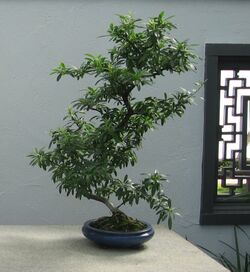Biology:Pyracantha crenulata
| Pyracantha crenulata | |
|---|---|

| |
| Pyracantha crenulata grown as a bonsai | |
| Scientific classification | |
| Kingdom: | Plantae |
| Clade: | Tracheophytes |
| Clade: | Angiosperms |
| Clade: | Eudicots |
| Clade: | Rosids |
| Order: | Rosales |
| Family: | Rosaceae |
| Genus: | Pyracantha |
| Species: | P. crenulata
|
| Binomial name | |
| Pyracantha crenulata (D.Don) M.Roem.
| |
| Synonyms[1] | |
|
List
| |
Pyracantha crenulata, the Nepalese firethorn,[2][3][4] Nepal firethorn or Himalayan firethorn, is a species of firethorn. The native range of this shrub species stretches from northern Pakistan to northwestern India and China.
Description
Pyracantha crenulata is a deciduous, bushy and profusely branched and very thorny shrub. It grows up to 2.4–3.0 m (7 ft 10.5 in–9 ft 10.1 in) tall. It has dark brown stem bark which becomes glabrous (hairless) when mature. It has dark green leaves,[5] with a smooth exterior. They are 2.5–4.0 cm (1.0–1.6 in) long and 1.0–2.2 cm (0.4–0.9 in) wide with a tapering end.[6] Flowering takes place between April and May.[5] The flowers are hermaphrodite (bisexual),[6][5] the white inflorescence is a compound corymb composed of many flowers. The flowers have 20 stamens and one ovary in the centre.[5] Every flower has five sepals and five petals.[6] The fruits ripen between June and September, with orange-red to dark red berry-like fruits.[5] The berries are small, and each berry weighs about 250 mg.[6] Each berry generally contains five triangular shaped and brown-colored seeds. There are sometimes three or four seeds per berry and the seeds are covered with a hard seed coat.[6]
Taxonomy
It is locally named as Ghingharu (घिंगारू) in Kumaon region of Uttarakhand, India.[5]
It was first published in Fam. Nat. Syn. Monogr. 3: 220 in 1847.[1]
Distribution
It is a native species to the countries (and regions) of; Assam, China, East and West Himalayas, India, Myanmar, Nepal, Pakistan, Tibet and Vietnam.[1]
It has been introduced into: United States (within the states of Alabama, California, Florida, Georgia, Louisiana, North Carolina, Oregon, South Carolina, Texas and Washington), South America (in north-eastern Argentina and Guatemala), Europe (Spain), South Africa (within Free State, Lesotho and Northern Provinces), Australia (in New South Wales) and north and south New Zealand.[1]
Habitat
Pyracantha crenulata is found growing in barren, rocky, and dry grasslands.[5] It is also found along streams on the bank of streams and tributaries, in shrubberies, on open slopes, in cultivated areas and along roadsides.[6]
On the Himalayan hills of Uttarakhand, it grows in areas at an altitude of 900–1,200 m (3,000–3,900 ft) above sea level,[5] within Pine and Quercus forests (Osmastan 1926).[7]
Uses
It is cultivated as an ornamental plant. The leaves are used to make herbal tea. The wood can be used to make walking sticks. The pome fruit is orange-red and are food for birds.
The plant is used in the Himalayas within herbal drugs and is usually collected from forest areas for therapeutic arrangements, such as brews of dehydrated fruits, fluid sources, and making tinctures. P. crenulate has been shown to help in the treatment of heart failure, cardiac issues, and hypertension. When eaten with yogurt, the berries of the shrub help patients recover from dysentery (Singh et al. 2012).[5]
It is also used for cultivation (in the Himalayas) near the boundaries of farming areas to stop soil erosion happening during the monsoon season due to its good soil binder capacity (via the roots) and it is used to prevent the entrance of wild animals (thorny bushes) into farming fields of vegetables and cereals.[8]
Gallery
References
- ↑ 1.0 1.1 1.2 1.3 "Pyracantha crenulata (D.Don) M.Roem. | Plants of the World Online | Kew Science" (in en). https://powo.science.kew.org/taxon/urn:lsid:ipni.org:names:730613-1.
- ↑ (xls) BSBI List 2007, Botanical Society of Britain and Ireland, https://bsbi.org/download/3542/, retrieved 2014-10-17
- ↑ "Pyracantha crenulata". Natural Resources Conservation Service PLANTS Database. USDA. https://plants.usda.gov/core/profile?symbol=PYCR7.
- ↑ {{citation | mode = cs1 | title = Pyracantha crenulata | work = Germplasm Resources Information Network (GRIN) | url = | publisher = [[Organization:Agricultural Research ServAgricultural Research Service (ARS), United States Department of Agriculture (USDA) | access-date = 2010-12-22 }}
- ↑ 5.0 5.1 5.2 5.3 5.4 5.5 5.6 5.7 5.8 Singh, R.; Negi, P.S.; Dwivedi, S.K. (2018). "Indian Hawthorn (Pyracantha crenulata).". New age herbals. Springer.. pp. 135–149.
- ↑ 6.0 6.1 6.2 6.3 6.4 6.5 Joshi, Rakesh Kumar; Laurindo, Lucas Fornari; Barbalho, Sandra M. (2023). "Chemical components and bioactivities of Pyracantha crenulata (D. Don) wild and cultivated from Uttarakhand, India: A review". American Journal of Essential Oils and Natural Products 11 (1): 34–37.
- ↑ Osmaston, A.E. (1926). A forest flora for Kumaon.. Delhi: Periodical Experts Book Agency.
- ↑ Gamble, J.S. (1972). A manual of Indian timbers: an account of the growth, distribution, and uses of the trees and shrubs of India and Ceylon, with descriptions of their wood-structure.. Dehradun: Bishen Singh Mahindra Pal Singh Publication.
External links
Other sources
- Guglani A., Rajeshwar K., Arya K., Pandey H.K., Singh A.K., Bisht D. Variation in antioxidant activity and phyto-constituents in different parts of Pyracantha crenulata collected from middle hill climatic condition of Western Himalayas. Nat. Volatiles & Essent. Oils. 2021;8(4):12455-12468. 20.
- Saklani S., Chandra S., Mishra A.P. Evaluation of nutritional profile, medicinal value and qualitative estimation in different parts of Pyrus pashia, Ficus palmate and Pyracantha crenulata. J global trends pharmaceutical sci. 2011; 2 (3) : 350–354.
- Sati D.C. Pharmacognostical and phytochemical screening of leaf and fruit extract of Pyracantha crenulata. J pharmacogn phytochem. 2017; 6 (5): 2563–8.
- Saklani S., Chandra S. In-vitro antimicrobial activity nutritional value, antinutritional value and phytochemical screening of Pyracantha crenulata fruit. Int J Pharm Sci Rev Res. 2014; 26 (1) :1-5.
Wikidata ☰ Q5240324 entry
 |



